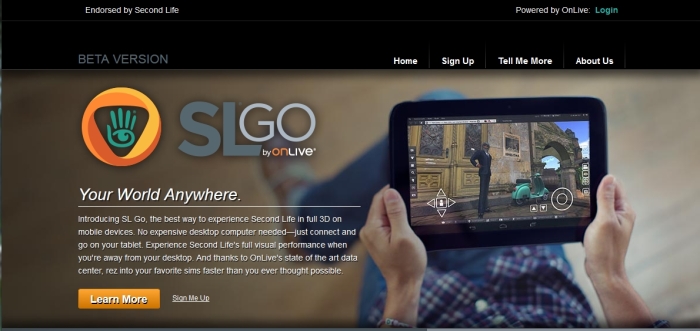 Important note: The SL Go service is to be shut down on April 30th, 2015. For more information, please read this report.
Important note: The SL Go service is to be shut down on April 30th, 2015. For more information, please read this report.
Update: On April 3rd, 2014, OnLive announced a revised pricing structure for SL Go, and on June 3rd, 2014, they announced the extension of the free trial period to 7 days.
On Wednesday March 5th, Linden Lab and OnLive, the streaming / cloud gaming company announced the launch of the SL Go by OnLive (SL Go) public beta (available to UK, US and Canadian residents at the moment).
SL Go is a service which streams the SL viewer and SL content directly to the user’s computer or tablet device (during the beta period, only Android is supported for tablets). As a streamed service, it allows, subject to network connectivity, the full richness and depth of Second Life to be displayed and used on tablets and low-end computer systems and laptops. The public beta is intended to broaden the use of the service, and to obtain further feedback in order to further enhance and refine it.
As a part of the preparations for the launch, I was one of a number of journalists and bloggers given preview access to the new service in order to try it out and provide initial reviews for readers. However, if you’re rather just skip ahead to the review part of this article, you can follow this link – but if you do, be warned, you’ll be missing out! 🙂 .
News that Linden Lab were involved in developing a mobile means of accessing Second Life first surfaced in October 2013, when selected users received an e-mail inviting them to sign-up for a closed beta for a new mobile service. Shortly after that, rumours began circulating that the work was linked with OnLive. Given the viewer’s complexity and the dynamic nature of SL content, using a streaming service is perhaps the only way in which to bring the full richness and depth of the SL experience provided by the viewer to devices such as tablets. Interestingly, however, the idea for using OnLive didn’t actually come from the Lab.

Instead, it actually came from Gary Lauder, OnLive’s Chairman and owner. His company, Lauder Partners, invested in the original OnLive Inc in 2009, and when that entity got into difficulties in 2012, then stepped-in and acquired OnLive in August 2012 and formed the current company using the name. Lauder has a working relationship with the Lab’s former CEO, Rod Humble, and being aware of Second Life, he approached Humble in early 2013 with the idea of forming a synergy between the two companies.
Lauder made his approach because third-person adventure games have been particularly successful for OnLive. As such, Second Life was seen as a logical choice for extending OnLive’s reach into more immersive environments while at the same time potentially offering Linden Lab with a solution for providing SL to tablet devices and to low-end desktop and laptop systems.
The task of initially investigating whether SL could be successfully run through OnLive servers was passed to Nick Barsetti, the Senior Manager of Customer Relations at OnLive. “One of my staff members and I were able to get it up and running on the service … and my jaw just absolutely dropped,” he says while discussing the service with Draxtor Despres ahead of the launch. “I said, ‘I’ve never seen it run this fast!’ It was prior to the server-side rending release [server-side appearance, July / August 2013]. And as we know, that has speeded-up local viewers quite a bit … even with that, it was running 150+ fps, and we’ve even seen it run as high as 200 fps on a private island.”
With the proof-of-concept a success, OnLive started into the core development work, with Barsetti playing a key role, being both a former Linden Lab employee (Scout Linden) and a long-time Second Life resident who has been actively engaged in the platform for seven years, notably as a community leader in a Star Wars role-play group. As such, he is intimately aware of how the viewer and platform can be used and very familiar with users’ expectations and requirements when running Second Life, and this is very apparent in his conversation with Drax, which you’ll be able to hear in The Drax Files Radio Hour on Friday March 7th.

SL Go is a service provided entirely by OnLive, which sits between the Lab’s servers and the user (and is, most likely, one of the contributing factors behind the August 2013 ToS changes). As such, it requires those wishing to use the service (including users with an existing OnLive account) to register at the SL Go website. Those who don’t have an account with OnLive will obtain one as a part of their SL Go registration. People with existing OnLive accounts will need to register with the SL Go website prior to being able to see SL Go through their OnLive client (computer or tablet).
Once registered, users can then purchase time credits for the service, download the SL Go app for Android via Google Play or the OnLive client for PCs or Macs in order to access SL Go.

New SL Go accounts receive a free trial period of 20 minutes 7 days (see the update at the top of this article, so that they can try the service to see if it suits their needs and assess how well it runs on their home or mobile network. Once this initial 20-minute period has been used, additional time credits can be purchased at the following rates:
$3.00 for one hour$8.00 for three hours (representing a 10% saving on the base cost)$25.00 for ten hours (representing a 15% saving on the base cost).
As noted at the top of this article in the updates, OnLive now charge a flat monthly subscription of US 9.95 (UK £6.95) per month for unlimited access to Second Life.
It is possible that some may balk at having to additionally pay for accessing Second Life. However, as Nate Barsetti explains, there is an underlying reason for charging for the service. “OnLive is another layer placed between you and the Linden Lab network. So in order to fund this and keep it going, there is a payment model associated with SL Go.” He also believes that the potential benefits in using SL Go will sufficiently offset reservations people have about paying for the service. Time will tell on this.
As well as using SL Go on either an Android tablet or a computer system, it is also possible to use SL Go with the OnLive Games System (OGS) to connect to a television and play games using a suitable USB or wireless keyboard and mouse and / or the included games controller (which can also be purchased separately).

As part of the preview, reviewers were supplied with a Samsung Galaxy Tab 3 10.1 with the SL Go app pre-installed, together with the OGS and a wireless keyboard for trying SL Go on a television, and a pre-assigned OnLive account. Unfortunately, I have been unable to test using SL Go with a television as a result of not being able to connect the OGS with my home network. As such, what follows is an overview of SL Go running on a tablet and on a low-end computer system (in this case, a 2010 PC EEE 1201N with 4 GB RAM and windows 7 home Edition, 32-bit).
Continue reading “SL Go: Second Life on a tablet, on the move and more”
